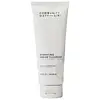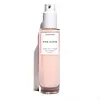What's inside
What's inside
 Key Ingredients
Key Ingredients

 Benefits
Benefits

 Concerns
Concerns

No concerns
 Ingredients Side-by-side
Ingredients Side-by-side

Ethylhexyl Palmitate
EmollientWater
Skin ConditioningCaprylic/Capric Triglyceride
MaskingPrunus Amygdalus Dulcis Oil
Skin ConditioningEuphorbia Cerifera Wax
Stearic Acid
CleansingCopernicia Cerifera Wax
Glyceryl Stearate Se
EmulsifyingTromethamine
BufferingIsostearic Acid
CleansingAvena Sativa Kernel Flour
AbrasiveLecithin
EmollientDisteardimonium Hectorite
StabilisingMagnesium Aluminum Silicate
AbsorbentCoco-Caprylate/Caprate
EmollientSodium Lauroyl Sarcosinate
CleansingSorbitan Stearate
EmulsifyingKaolin
AbrasiveSaccharomyces Ferment
Skin ConditioningTriheptanoin
Skin ConditioningDecyl Glucoside
CleansingC9-12 Alkane
SolventPolyurethane-10
1,2-Hexanediol
Skin ConditioningSodium Benzoate
MaskingCaprylyl Glycol
EmollientAllantoin
Skin ConditioningTocopheryl Acetate
AntioxidantIsohexadecane
EmollientButylene Glycol
HumectantLauroyl Lysine
Skin ConditioningLauryl Glucoside
CleansingSorbitan Oleate
EmulsifyingCitric Acid
BufferingAloe Barbadensis Leaf Juice
Skin ConditioningHydroxyacetophenone
AntioxidantSodium Hyaluronate
HumectantHippophae Rhamnoides Fruit Extract
Skin ConditioningPanthenol
Skin ConditioningAnthemis Nobilis Flower Extract
MaskingCamellia Sinensis Leaf Extract
AntimicrobialEucalyptus Globulus Leaf Extract
PerfumingLavandula Angustifolia Flower/Leaf/Stem Extract
MaskingMentha Viridis Extract
MaskingPogostemon Cablin Leaf Extract
PerfumingRose Extract
Skin ConditioningQuartz
AbrasiveZingiber Officinale Extract
Skin ConditioningCurcuma Longa Root Extract
MaskingEthylhexyl Palmitate, Water, Caprylic/Capric Triglyceride, Prunus Amygdalus Dulcis Oil, Euphorbia Cerifera Wax, Stearic Acid, Copernicia Cerifera Wax, Glyceryl Stearate Se, Tromethamine, Isostearic Acid, Avena Sativa Kernel Flour, Lecithin, Disteardimonium Hectorite, Magnesium Aluminum Silicate, Coco-Caprylate/Caprate, Sodium Lauroyl Sarcosinate, Sorbitan Stearate, Kaolin, Saccharomyces Ferment, Triheptanoin, Decyl Glucoside, C9-12 Alkane, Polyurethane-10, 1,2-Hexanediol, Sodium Benzoate, Caprylyl Glycol, Allantoin, Tocopheryl Acetate, Isohexadecane, Butylene Glycol, Lauroyl Lysine, Lauryl Glucoside, Sorbitan Oleate, Citric Acid, Aloe Barbadensis Leaf Juice, Hydroxyacetophenone, Sodium Hyaluronate, Hippophae Rhamnoides Fruit Extract, Panthenol, Anthemis Nobilis Flower Extract, Camellia Sinensis Leaf Extract, Eucalyptus Globulus Leaf Extract, Lavandula Angustifolia Flower/Leaf/Stem Extract, Mentha Viridis Extract, Pogostemon Cablin Leaf Extract, Rose Extract, Quartz, Zingiber Officinale Extract, Curcuma Longa Root Extract
Water
Skin ConditioningRosa Damascena Flower Water
MaskingDecyl Glucoside
CleansingGlycerin
HumectantSodium Lauroyl Lactylate
EmulsifyingSqualane
EmollientGlyceryl Caprylate
EmollientXanthan Gum
EmulsifyingGlyceryl Stearate
EmollientTremella Fuciformis Sporocarp Extract
AntioxidantCaprylhydroxamic Acid
Camellia Sinensis Leaf Extract
AntimicrobialAloe Barbadensis Leaf Juice
Skin ConditioningCitric Acid
BufferingEclipta Prostrata Extract
Skin ConditioningSodium Hyaluronate
HumectantMelia Azadirachta Leaf Extract
Skin ConditioningMoringa Oleifera Seed Oil
EmollientCocos Nucifera Fruit Juice
EmollientTapioca Starch
Water, Rosa Damascena Flower Water, Decyl Glucoside, Glycerin, Sodium Lauroyl Lactylate, Squalane, Glyceryl Caprylate, Xanthan Gum, Glyceryl Stearate, Tremella Fuciformis Sporocarp Extract, Caprylhydroxamic Acid, Camellia Sinensis Leaf Extract, Aloe Barbadensis Leaf Juice, Citric Acid, Eclipta Prostrata Extract, Sodium Hyaluronate, Melia Azadirachta Leaf Extract, Moringa Oleifera Seed Oil, Cocos Nucifera Fruit Juice, Tapioca Starch
 Reviews
Reviews

Alternatives
Ingredients Explained
These ingredients are found in both products.
Ingredients higher up in an ingredient list are typically present in a larger amount.
Aloe Barbadensis Leaf Juice comes from leaves of the aloe plant. Aloe Barbadensis Leaf Juice is best known for helping to soothe sunburns. It is also anti-inflammatory, moisturizing, antiseptic, and can help heal wounds.
Aloe is packed with good stuff including Vitamins A, C, and E. These vitamins are antioxidants, which help fight free-radicals and the damage they may cause. Free-radicals are molecules that may damage your skin cells, such as pollution.
Aloe Barbadensis Leaf Juice also contains sugars. These sugars come in the form of monosaccharides and polysaccharides, folic acid, and choline. These sugars are able to help bind moisture to skin.
It also contains minerals such as calcium, 12 anthraquinones, fatty acids, amino acids, and Vitamin B12.
Learn more about Aloe Barbadensis Leaf JuiceCamellia Sinensis Leaf Extract is derived from the leaves of the tea plant. Black tea, green tea, and oolong tea are all harvested from this plant.
This ingredient has many skin benefits:
This ingredient contains polyphenols, a strong antioxidant. Antioxidants help fight off molecules that damage skin cells.
On top of that, the antioxidants in green tea neutralize free-radicals from the sun. This gives the skin some extra UV protection, but should not replace sunscreen.
Many components of tea have anti-inflammatory properties.
Polyphenols and L-theanine help soothe the skin and reduce irritation. The caffeine in Camellia Sinensis Leaf Extract helps calm inflamed blood vessels.
Other compounds found in tea include: Vitamin Bs, linoleic acid, magnesium, calcium, iron, and zinc.
Research has shown both drinking Camellia Sinensis Leaf Tea and applying it to the skin can help boost skin elasticity and hydration. Studies also show using tea extract may reduce sebum, or oil, production.
Learn more about Camellia Sinensis Leaf ExtractCitric Acid is an alpha hydroxy acid (AHA) naturally found in citrus fruits like oranges, lemons, and limes.
Like other AHAs, citric acid can exfoliate skin by breaking down the bonds that hold dead skin cells together. This helps reveal smoother and brighter skin underneath.
However, this exfoliating effect only happens at high concentrations (20%) which can be hard to find in cosmetic products.
Due to this, citric acid is usually included in small amounts as a pH adjuster. This helps keep products slightly more acidic and compatible with skin's natural pH.
In skincare formulas, citric acid can:
While it can provide some skin benefits, research shows lactic acid and glycolic acid are generally more effective and less irritating exfoliants.
Most citric acid used in skincare today is made by fermenting sugars (usually from molasses). This synthetic version is identical to the natural citrus form but easier to stabilize and use in formulations.
Read more about some other popular AHA's here:
Learn more about Citric AcidDecyl Glucoside is a glucose-based surfactant and emulsion stabilizer. It is created by reacting glucose with the fatty acids from plants.
Surfactants help clean the skin by trapping oil, sebum, and dirt to be washed away. As an emulsion stabilizer, it stabilizes the ingredients in a product by preventing them from separating.
This ingredient is biodegradable and non-toxic. This ingredient is commonly found in baby shampoos.
Decyl Glucoside is sometimes used to stabilize the UV filter Tinosorb.
Learn more about Decyl GlucosideSodium Hyaluronate is hyaluronic acid's salt form. It is commonly derived from the sodium salt of hyaluronic acid.
Like hyaluronic acid, it is great at holding water and acts as a humectant. This makes it a great skin hydrating ingredient.
Sodium Hyaluronate is naturally occurring in our bodies and is mostly found in eye fluid and joints.
These are some other common types of Hyaluronic Acid:
Learn more about Sodium HyaluronateWater. It's the most common cosmetic ingredient of all. You'll usually see it at the top of ingredient lists, meaning that it makes up the largest part of the product.
So why is it so popular? Water most often acts as a solvent - this means that it helps dissolve other ingredients into the formulation.
You'll also recognize water as that liquid we all need to stay alive. If you see this, drink a glass of water. Stay hydrated!
Learn more about Water